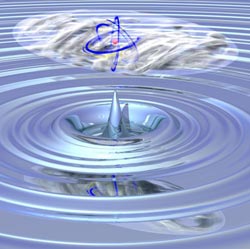Giant atom eats quantum gas

Rydberg-Atom<br>University of Stuttgart, 5. Physikalische Institut <br><br> Illustration of the system investigated: A highly excited Rydberg-atom, consisting of a single electron (blue), traveling on a large orbit far from the positively charged core (red). The Rydberg atom has the same spatial extent as the ultracold atomic cloud. The single electron is exciting oscillations, so called phonons, in the surrounding quantum gas.
The interaction of electrons and matter is fundamental to material properties such as electrical conductivity. Electrons are scattering from atoms of the surrounding matter and can excite lattice oscillations, so called phonons, thereby transferring energy to the environment. The electron is therefore slowed which causes electrical resistance.
However, in certain materials phonons can surprisingly cause the opposite effect, so called superconductivity, where the electrical resistance drops to zero. Understanding the interaction of electrons and matter is therefore important goal in order to both answer fundamental questions as well as to solve technical problems.
A single electron is best suited for systematic investigations of such processes. For the first time, physicists from Stuttgart have now realized a model system in the laboratory, where the interaction of a single electron with many atoms inside its orbital can be studied. These atoms are from an ultracold cloud near absolute zero, a so called Bose-Einstein condensate.
The basic idea now is simple: Instead of using a technically challenging electron trap, the scientists are using the fact that in nature electrons are bound to a positively charged atomic core. In a classical picture, they are travelling on ellipsoidal orbits around the core. These orbits are usually very small, typically in the range below one nanometer. In order to achieve an interaction between an electron and many atoms, an atom is excited from a cloud consisting of 100.000 atoms using laser light.
The orbit of a single electron then expands to several micrometers and a Rydberg atom is formed. On atomic length scales, this atom is huge, larger than most bacteria, which are consisting each of + several billions to trillions of atoms. The Rydberg atom is then containing tens of thousands of atoms from the cold cloud. Thus, a situation is realized where the electron is trapped in a defined volume and at the same time interacts with a large number of atoms.
This interaction is so strong that the whole atomic cloud, consisting of 100,000 atoms is considerably influenced by the single electron. Depending on its quantum state the electron excites phonons in the atomic cloud, which can be measured as collective oscillations of the whole cloud culminating in a loss of atoms from the trap.
The experimental observations in the group of Prof. Tilman Pfau could so far largely be explained by collaborative work with the theory group of Prof. Hans Peter Büchler. However, this work is only the basis for a series of further exciting experiments. According to the previous studies an electron is leaving a clear trace in the surrounding atomic cloud. Therefore imaging a single electron in a well defined quantum state seems to be feasible. Due to the impact on various fields, including quantum optics, these results were published in the highly respected journal Nature *).
This work has been realized within Sonderforschungsbereich SFB/TRR 21 (Control of quantum correlations in tailored matter) and has been supported by the Detusche Forschungsgemeinschaft DFG and the European Research Council.
*) J.B. Balewski, A.T. Krupp, A. Gaj, D. Peter, H.P. Büchler, R. Löw, S. Hofferberth and T. Pfau, Coupling a single electron to a Bose-Einstein condensate; Nature, doi:10.1038/nature12592
Further information:
Prof. Tilman Pfau, Jonathan Balewski, 5. Physikalisches Institut, Tel. +49 711/685-64820, e-mail: t.pfau@physik.uni-stuttgart.de, j.balewski@physik.uni-stuttgart.de
Media Contact
More Information:
http://www.pi5.uni-stuttgart.deAll latest news from the category: Physics and Astronomy
This area deals with the fundamental laws and building blocks of nature and how they interact, the properties and the behavior of matter, and research into space and time and their structures.
innovations-report provides in-depth reports and articles on subjects such as astrophysics, laser technologies, nuclear, quantum, particle and solid-state physics, nanotechnologies, planetary research and findings (Mars, Venus) and developments related to the Hubble Telescope.
Newest articles

“Nanostitches” enable lighter and tougher composite materials
In research that may lead to next-generation airplanes and spacecraft, MIT engineers used carbon nanotubes to prevent cracking in multilayered composites. To save on fuel and reduce aircraft emissions, engineers…

Trash to treasure
Researchers turn metal waste into catalyst for hydrogen. Scientists have found a way to transform metal waste into a highly efficient catalyst to make hydrogen from water, a discovery that…

Real-time detection of infectious disease viruses
… by searching for molecular fingerprinting. A research team consisting of Professor Kyoung-Duck Park and Taeyoung Moon and Huitae Joo, PhD candidates, from the Department of Physics at Pohang University…





















